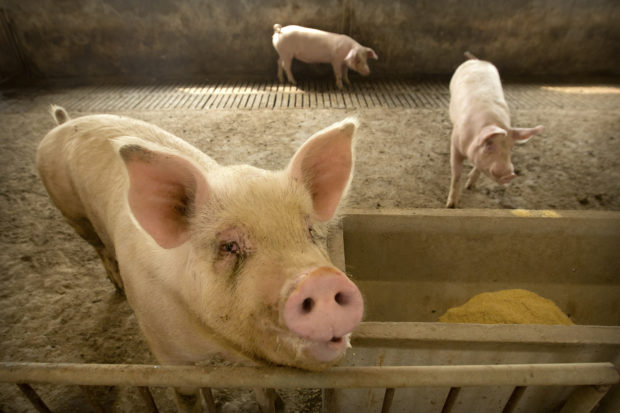BEIJING – Hong Kong retiree Lee Wai-man loves pork fresh from the market but eats a lot less now that the price has jumped 40 percent as China’s struggle with outbreaks of a deadly swine disease sends shockwaves through global meat markets.
China produces and consumes two-thirds of the world’s pork, but output is plunging as Beijing destroys herds and blocks shipments to stop African swine fever.
Importers are filling the gap by buying pork as far away as Europe, boosting prices and causing shortages in other markets.
“I’m a fresh-pork lover, but it’s too expensive,” Lee, 87, said as she shopped at a Hong Kong market.

In this May 8, 2019, photo, pigs stand in a barn at a pig farm in Jiangjiaqiao village in northern China’s Hebei province. Pork lovers worldwide are wincing at prices that have jumped by up to 40 percent as China’s struggle to stamp out African swine fever in its vast pig herds sends shockwaves through global meat markets. (AP Photo/Mark Schiefelbein)
African swine fever doesn’t harm humans but is fatal and spreads quickly among pigs.
It was first reported in August in China’s northeast.
Since then, 1 million pigs have died and the disease has spread to 31 of China’s 34 provinces, according to the U.N. Food and Agriculture Organization.
The outbreak’s scale is unprecedented, said Dirk Pfeiffer, a veterinary epidemiologist at the City University of Hong Kong.
“This is probably the most complex animal disease we have ever had to deal with,” Pfeiffer said.
China’s shortfall is likely to be so big it will match Europe’s annual pork output and exceed U.S. production by 30%, industry researchers say.
“Everyone wants to import as much pork as possible,” said industry analyst Angela Zhang of IQC Insights. She said the trend is likely to accelerate as Chinese production falls.
That’s a boost for farmers in Germany, Spain and other countries with healthy pigs but hard on families in Southeast Asia and other poor markets that rely on pork for protein.
This year’s Chinese pork output might fall by up to 35%, according to Rabobank, a Dutch bank.
Global supplies will be “redirected to China,” the bank’s researchers said in an April report. It said the “unprecedented shift” in trade will likely cause shortages in other markets.
Grocery shoppers in Germany, Japan and other high-income markets grumble at paying more for kielbasa or tonkatsu, but short supplies are a serious concern in places such as Cambodia where pork is the only meat many families can afford.
Cambodia’s live hog price jumped 37% in the past six months, according to Srun Pov, president of the Cambodia Livestock Raiser Association.
He said the country is buying about 30% of its daily needs of 500-600 tons from Thailand.
“Pork is important to us,” said Chhe Pich as a butcher weighed her purchase in the Cambodian capital, Phnom Penh.
“Even though the current price is a bit high, I have to buy it to serve my family.”
The U.S. Department of Agriculture expects China’s pork imports to soar 41% this year over 2018 to 2.2 million tons.
There’s no immediate end in sight as “evidence mounts that China will be unable to eradicate ASF in the near-term,” it said in a recent report.
The jolt to the global meat industry highlights China’s voracious demand for food for its 1.4 billion people, the potential for wider disruptions if its own production falters and its growing ability to outbid other customers for supplies. /gg

